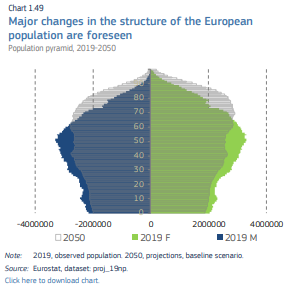
Published on September 15, the report on employment and social developments in Europe presents the economic situation and highlights trends for the future of the old continent. Despite the crisis generated by the Covid-19 pandemic, the indicators revealed in this document offer interesting opportunities for the home employment sector.
Among them, the employment rate of the population aged 20-64 reached 73.1% in the European Union in 2019, 0.7 percentage points higher than in 2018. The service sector contributed most to this increase, registering 1.6 million new workers (+1.2%) for that same year. This can be illustrated by a boom in social, care and health activities, as well as scientific and technical activities.
Even if there were progresses recorded, the employment gap between men and women remains stable. It stood at 11.7% in 2019 according to Eurostat, however, it could increase in the coming months. In fact, the measures implemented by some Member States to avoid the spread of the virus have had a stronger impact on women, as they are more represented in vulnerable sectors. It is therefore crucial to support women’s access to the labour market through the implementation of the European Pillar of Social Rights (EPSR) and the Gender Equality Strategy.

Because of the pandemic, the contraction of the economy (4.4% in 2020) will not allow the European Union to reach its EU2020 employment target (75%). Nevertheless, the recovery programmes of the Member States, supported by the Next Generation EU fund, should gradually boost activity and employment in the EU. The personal and household services (PHS) sector could benefit from this growth, particularly in major metropolises since the pandemic has changed consumers’ behaviour and their perception of home service. It is therefore essential that Member States put in place measures to promote home employment to avoid the expansion of undeclared work.
Demographic changes will gradually increase the need for personal and household services (PHS) in the European Union. Eurostat does not expect the European population to increase between 2019 and 2050, falling from 446.8 million to 441.2 million. However, major socio-economic changes could change its structure, such as ageing, a shrinking working population and rising education levels.
Over this period, the European population aged 15-64 is expected to decrease by 38 million people, according to Eurostat estimates. Conversely, the population aged over 80 is expected to increase by 26 million. The population pyramid below illustrates this demographic change by gender.

These trends emphasize the need to increase women’s participation in the labour market to meet the challenges of tomorrow, such as the sustainability of pension schemes. The outsourcing of family and domestic responsibilities appears to be a major step to enhance their work-life balance, since they are usually carried out by women. When supported by Member States, declared home employment offers interesting alternatives to European households. This is the reason why they need to facilitate their recognition through the implementation of declarative scheme for domestic and care workers.